Case study: converting a Shiny app to async
Source:vignettes/promises_08_casestudy.Rmd
promises_08_casestudy.RmdIn this case study, we’ll work through an application of reasonable complexity, turning its slowest operations into mirai/promises and modifying all the downstream reactive expressions and outputs to deal with promises.
Motivation
As a web service increases in popularity, so does the number of rogue scripts that abuse it for no apparent reason.
—Joe Cheng’s Law of Why We Can’t Have Nice Things
I first noticed this in 2011, when the then-new RStudio IDE was starting to gather steam. We had a dashboard that tracked how often RStudio was being downloaded, and the numbers were generally tracking smoothly upward. But once every few months, we’d have huge spikes in the download counts, ten times greater than normal—and invariably, we’d find that all of the unexpected increase could be tracked to one or two IP addresses.
For hours or days we’d be inundated with thousands of downloads per
hour, then just as suddenly, they’d cease. I didn’t know what was
happening then, and I still don’t know today. Was it the world’s least
competent denial-of-service attempt? Did someone write a download script
with an accidental while (TRUE) around it?
Our application will let us examine downloads from CRAN for this kind of behavior. For any given day on CRAN, we’ll see what the top downloaders are and how they’re behaving.
Our source data
RStudio maintains the popular 0-Cloud CRAN mirror, and
the log files it generates are freely available at http://cran-logs.rstudio.com/. Each day is a separate
gzipped CSV file, and each row is a single package download. For
privacy, IP addresses are anonymized by substituting each day’s IP
addresses with unique integer IDs.
Here are the first few lines of http://cran-logs.rstudio.com/2018/2018-05-26.csv.gz :
"date","time","size","r_version","r_arch","r_os","package","version","country","ip_id"
"2018-05-26","20:42:23",450377,"3.4.4","x86_64","linux-gnu","lubridate","1.7.4","NL",1
"2018-05-26","20:42:30",484348,NA,NA,NA,"homals","0.9-7","GB",2
"2018-05-26","20:42:21",98484,"3.3.1","x86_64","darwin13.4.0","miniUI","0.1.1.1","NL",1
"2018-05-26","20:42:27",518,"3.4.4","x86_64","linux-gnu","RCurl","1.95-4.10","US",3Fortunately for our purposes, there’s no need to analyze these logs at a high level to figure out which days are affected by badly behaved download scripts. These CRAN mirrors are popular enough that, according to Cheng’s Law, there should be plenty of rogue scripts hitting it every day of the year.
A tour of the app
The app I built to explore this data, cranwhales, let us examine the behavior of the top downloaders (“whales”) for any given day, at varying levels of detail. You can view this app live at https://gallery.shinyapps.io/cranwhales/, or download and run the code yourself at https://github.com/rstudio/cranwhales.
When the app starts, the “All traffic” tab shows you the number of package downloads per hour for all users vs. whales. In this screenshot, you can see the proportion of files downloaded by the top six downloaders on May 28, 2018. It may not look like a huge fraction at first, but keep in mind, we are only talking about six downloaders out of 52,815 total!
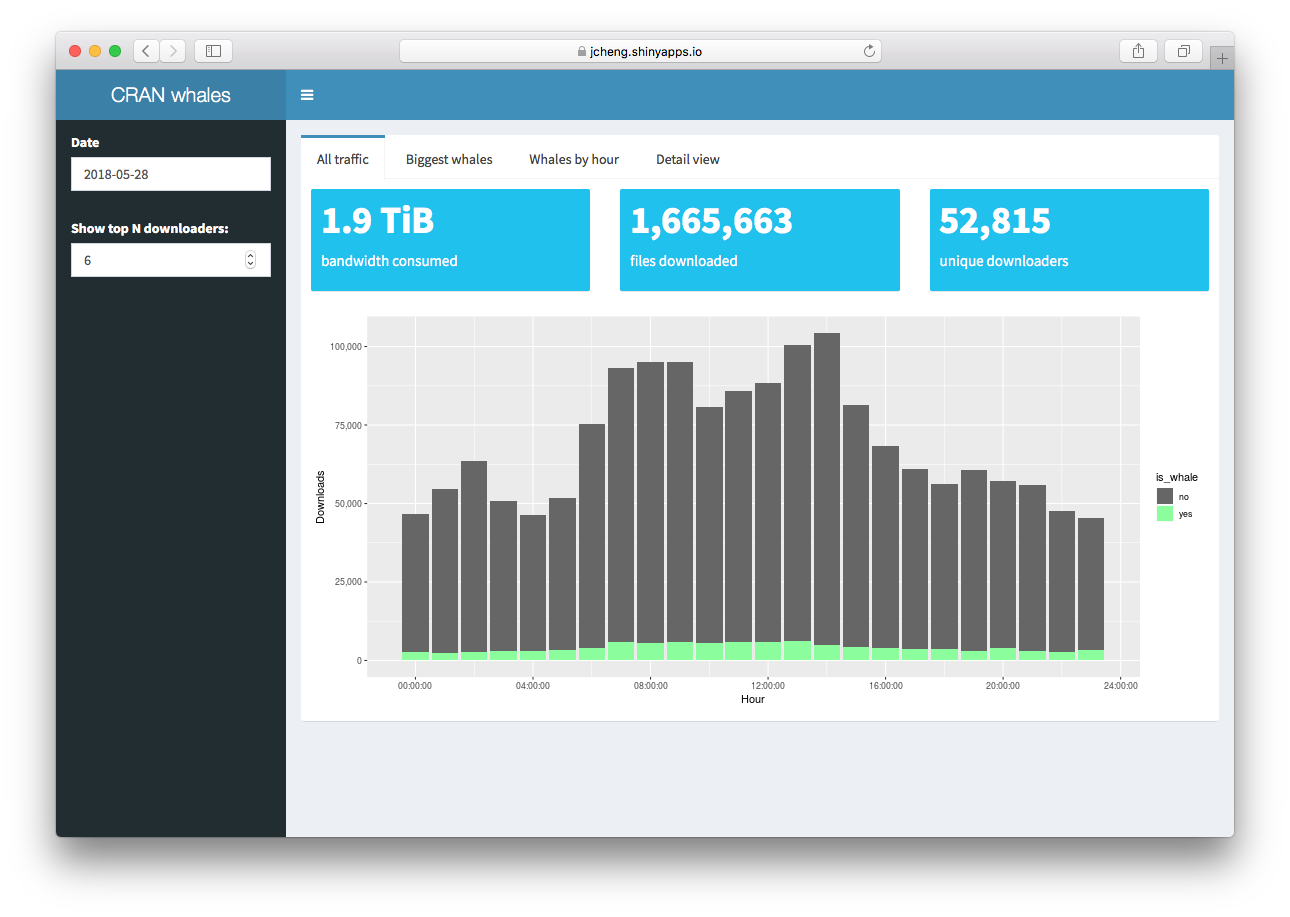
The “Biggest whales” tab simply shows the most prolific downloaders, with their number of downloads performed. Each anonymized IP address has been assigned an easier-to-remember name, and you can also see the country code of the original IP address.
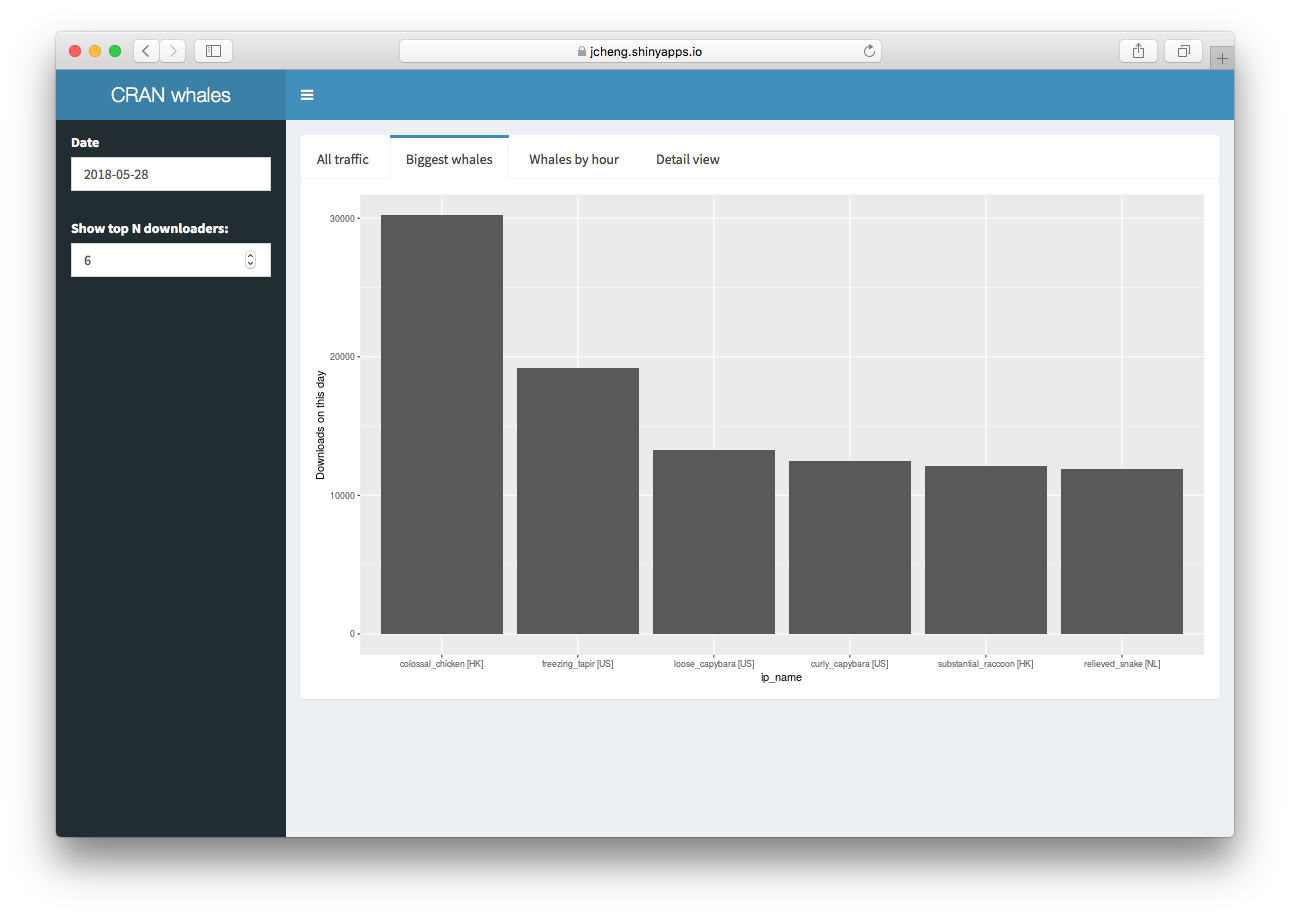
The “Whales by hour” tab shows the hourly download counts for each
whale individually. In this screenshot, you can see that the
Netherlands’ relieved_snake downloaded at an extremely
consistent rate during the whole day, while the American
curly_capabara was active only during business hours in
Eastern Standard Time. Still others, like colossal_chicken
out of Hong Kong, was busy all day but at varying rates.
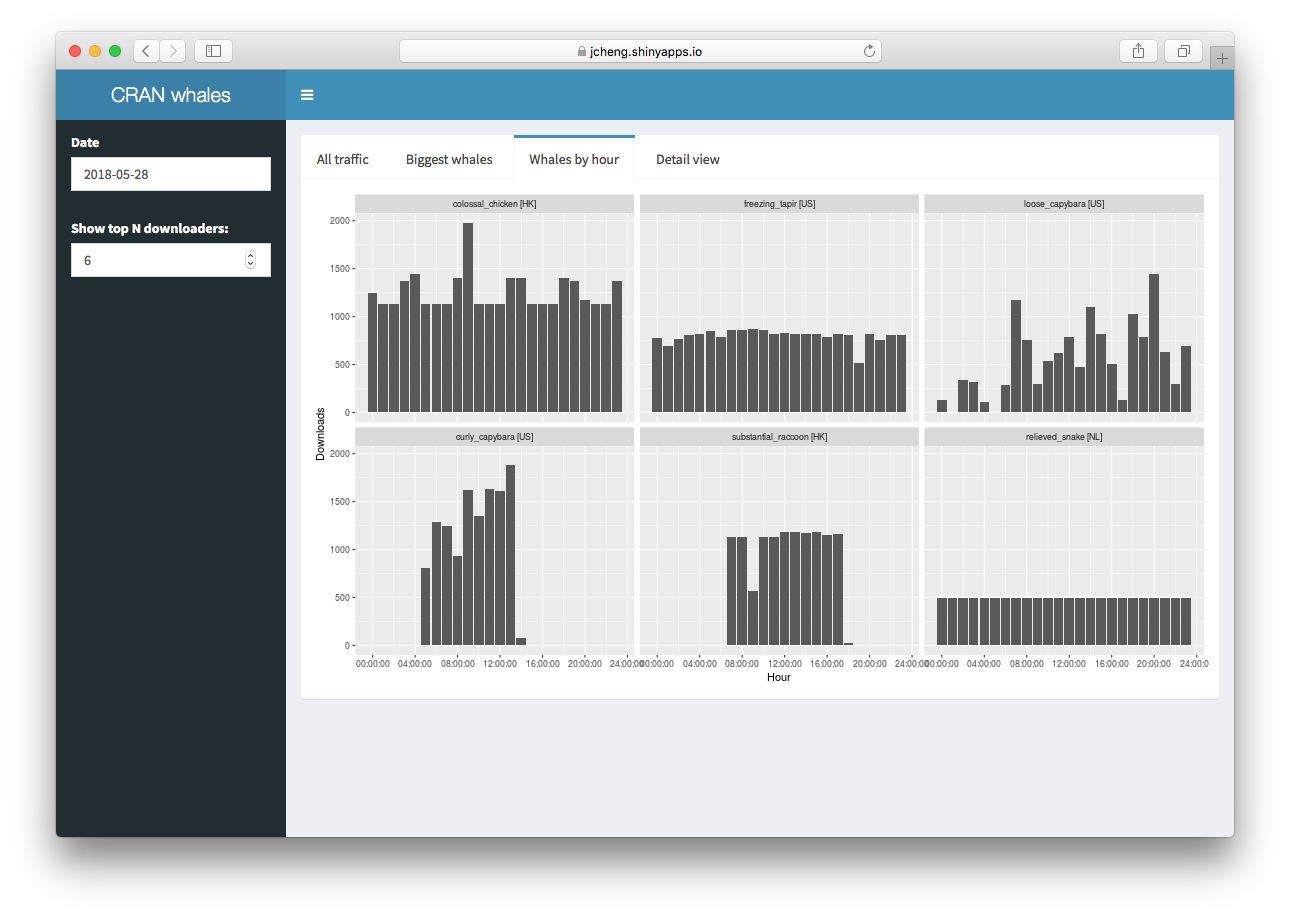
The “Detail View” has perhaps the most illuminating information. It
lets you view every download made by a given whale on the day in
question. The x dimension is time and the y dimension is what package
they downloaded, so you can see at a glance exactly how many packages
were downloaded, and how their various package downloads relate to each
other. In this case, relieved_snake downloaded 104
different packages, in the same order, continuously, for the entire
day.
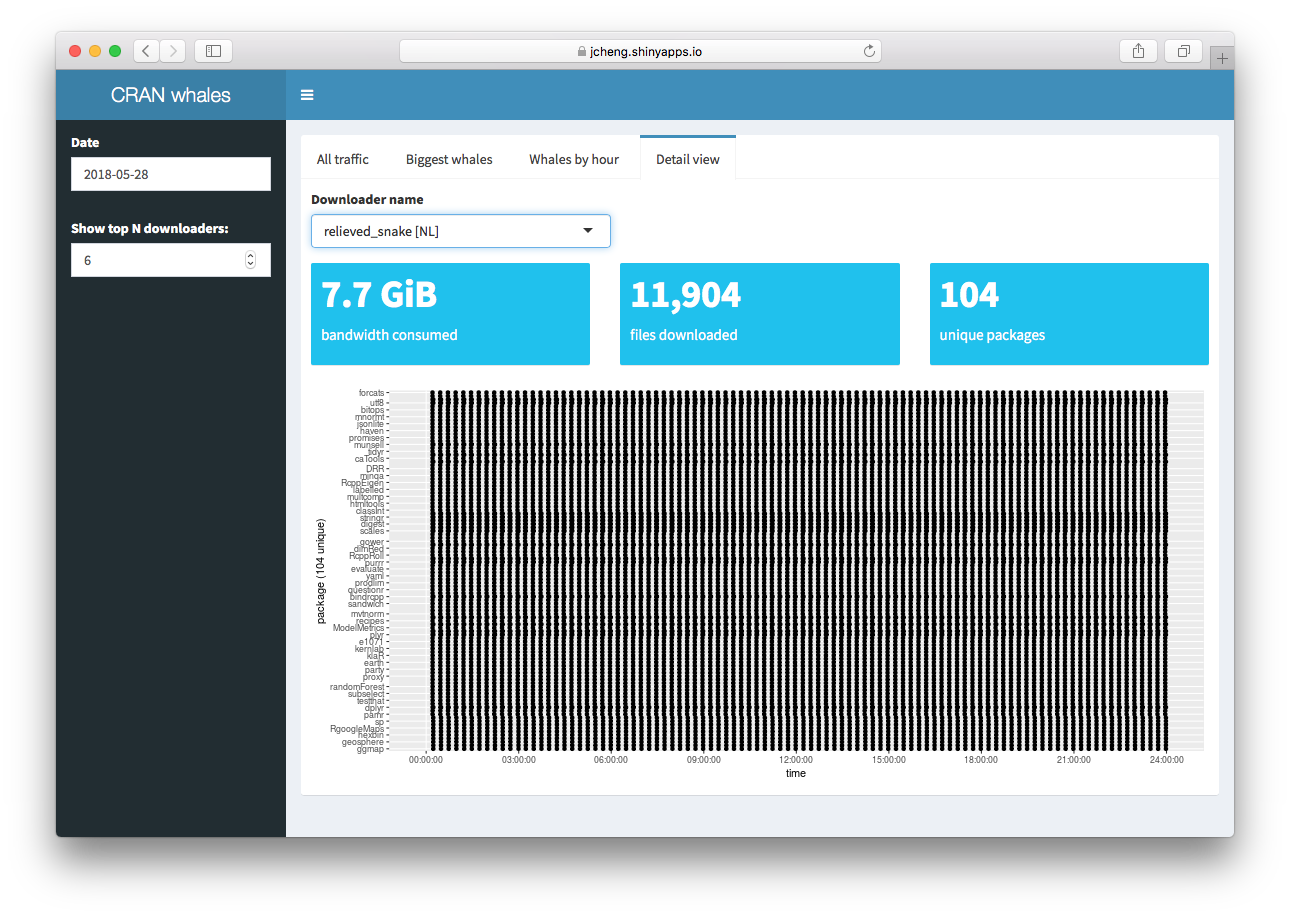
relieved_snake downloads 104 packages continuously all day
long.Others behave very differently, like freezing_tapir, who
downloaded devtools–and only
devtools–for the whole day, racking up 19,180 downloads
totalling 7.9 gigabytes for that one package alone!
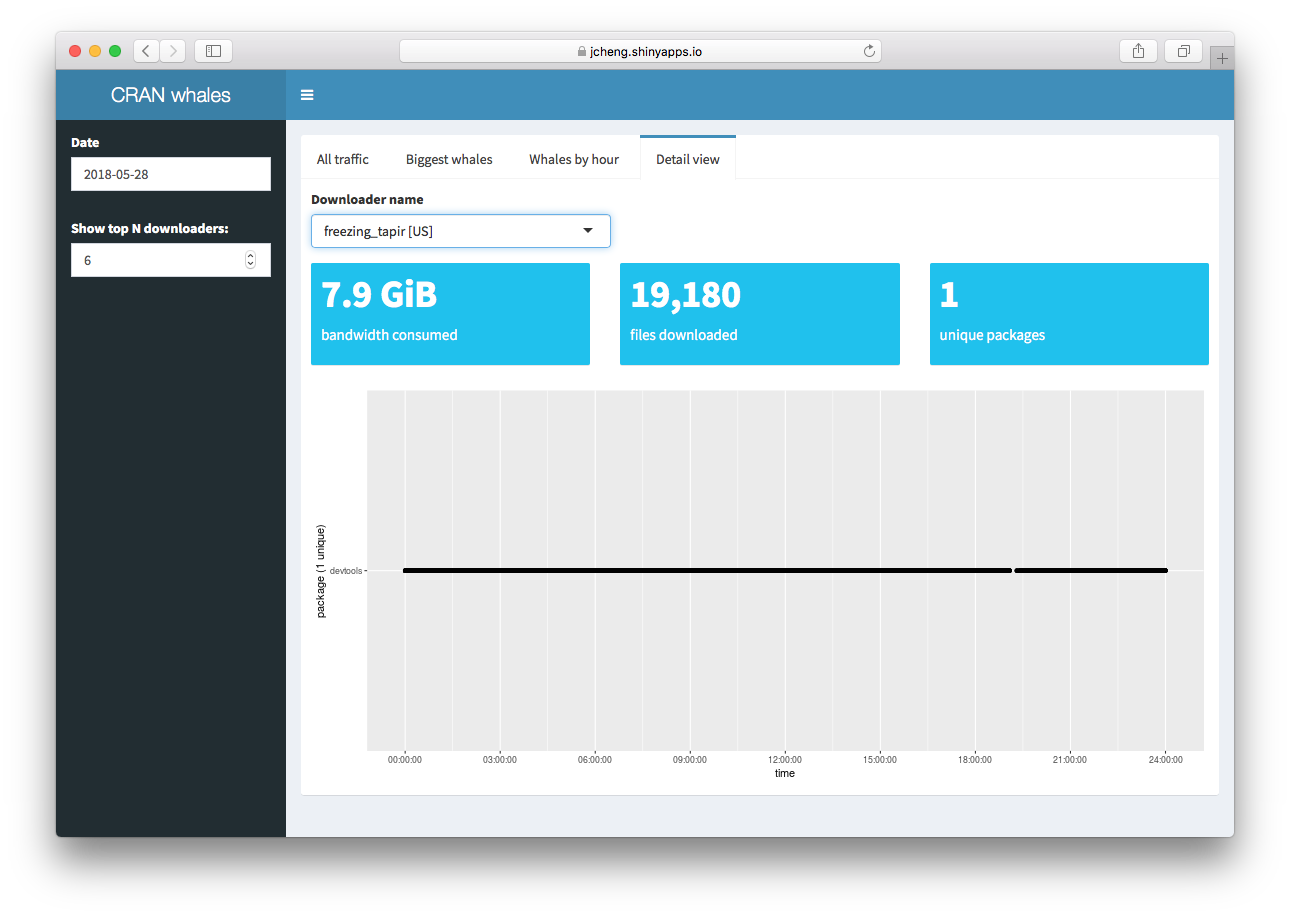
freezing_tapir only downloads devtools
continuously all day long.Sadly, the app can’t tell us any more than that–it can’t explain why these downloaders are behaving this way, nor can it tell us their street addresses so that we can send ninjas in black RStudio helicopters to make them stop.
The implementation
Now that you’ve seen what the app does, let’s talk about how it was implemented, then convert it from sync to async.
User interface
The user interface is a pretty typical shinydashboard. It’s important to note that the UI part of the app is entirely agnostic to whether the server is written in the sync or async style; when we port the app to async, we won’t touch the UI at all.
There are two major pieces of input we need from users: what date to examine (this app only lets us look at one day at a time) and how many of the most prolific downloaders to look at. We’ll put these two controls in the dashboard sidebar.
dashboardSidebar(
dateInput("date", "Date", value = Sys.Date() - 2),
numericInput("count", "Show top N downloaders:", 6)
)(We set date to two days ago by default, because there’s
some lag between when a day ends and when its logs are published.)
The rest of the UI code is just typical shinydashboard scaffolding,
plus some shinydashboard::valueBoxOutputs and
plotOutputs. These are so trivial that they’re hardly worth
talking about, but I’ll include the code here for completeness. Finally,
there’s detailViewUI, a Shiny
module that just contains more of the same (value boxes and
plots).
dashboardBody(
fluidRow(
tabBox(width = 12,
tabPanel("All traffic",
fluidRow(
valueBoxOutput("total_size", width = 4),
valueBoxOutput("total_count", width = 4),
valueBoxOutput("total_downloaders", width = 4)
),
plotOutput("all_hour")
),
tabPanel("Biggest whales",
plotOutput("downloaders", height = 500)
),
tabPanel("Whales by hour",
plotOutput("downloaders_hour", height = 500)
),
tabPanel("Detail view",
detailViewUI("details")
)
)
)
)Server logic
Based on these inputs and outputs, we’ll write a variety of reactive expressions and output renderers to download, manipulate, and visualize the relevant log data.
The reactive expressions:
-
data(eventReactive): Wheneverinput$datechanges, thedatareactive downloads the full log for that day from http://cran-logs.rstudio.com, and parses it. -
whales(reactive): Reads fromdata(), tallies the number of downloads performed by each unique IP, and returns a data frame of the topinput$countmost prolific downloaders, along with their download counts. -
whale_downloads(reactive): Joins thedata()andwhales()data frames, to return all of the details of the cetacean downloads.
The whales reactive expression depends on
data, and whale_downloads depends on
data and whales.
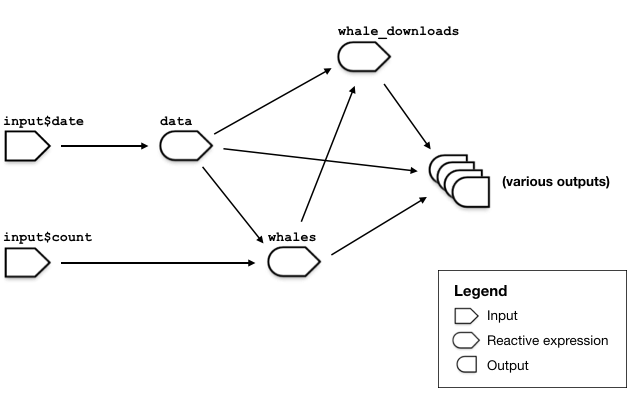
The outputs in this app are mostly either renderPlots
that we populate with ggplot2, or
shinydashboard::renderValueBoxes. They all rely on one or
more of the reactive expressions we just described. We won’t catalog
them all here, as they’re not individually interesting, but we will look
at some archetypes below.
Improving performance and scalability
While this article is specifically about async, this is a good time to remind you that there are lots of ways to improve the performance of a Shiny app. Async is just one tool in the toolbox, and before reaching for that hammer, take a moment to consider your other options:
- Have I used profvis to profile my code and determine what’s actually taking so long? (Human intuition is a notoriously bad profiler!)
- Can I perform any calculations, summarizations, and aggregations offline, when my Shiny app isn’t even running, and save the results to .rds files to be read by the app?
- Are there any opportunities to cache–that is, save the results of my calculations and use them if I get the same request later? (See memoise, or roll your own.)
- Am I effectively leveraging reactive programming to make sure my reactives are doing as little work as possible?
- When deploying my app, am I load balancing across multiple R processes and/or multiple servers? (Shiny Server Pro, RStudio Connect, ShinyApps.io)
These options are more generally useful than using async techniques because they can dramatically speed up the performance of an app even if only a single user is using it. While it obviously depends on the particulars of the app itself, a few lines of precomputation or caching logic can often lead to 10X-100X better performance. Async, on the other hand, generally doesn’t help make a single session faster. Instead, it helps a single Shiny process support more concurrent sessions without getting bogged down.
Async can be an essential tool when there is no way around performing expensive tasks (i.e. taking multiple seconds) while the user waits. For example, an app that analyzes any user-specified Twitter profile may get too many unique queries (assuming most people specify their own Twitter handle) for caching to be much help. And applications that invite users to upload their own datasets won’t have an opportunity to do any offline summarizing in advance. If you need to run apps like that and support lots of concurrent users, async can be a huge help.
In that sense, the cranwhales app isn’t a perfect example, because it has lots of opportunities for precomputation and caching that we’ll willfully ignore today so that I can better illustrate the points I want to make about async. When you’re working on your own app, though, please think carefully about all of the different techniques you have for improving performance.
Converting to async
To quote the article Using promises with Shiny, async programming with Shiny boils down to following a few steps:
- Identify slow operations in your app.
- Convert the slow operations into mirai.
- Any code that relies on the result of those operations (if any), whether directly or indirectly, now must be converted to promise handlers that operate on the mirai object.
In this case, the slow operations are easy to identify: the
downloading and parsing that takes place in the data
reactive expression can each take several long seconds.
Converting the download and parsing operations into mirai turns out to be the most complicated part of the process, for reasons we’ll get into later.
Assuming we do that successfully, the data reactive
expression will no longer return a data frame, but a
promise object (that resolves to a data frame). Since the
whales and whale_downloads reactive
expressions both rely on data, those will both also need to
be converted to read and return promise objects. And
therefore, because the outputs all rely on one or more reactive
expressions, they will all need to know how to deal with
promise objects.
Async code is infectious like that; once you turn the heart of your app into a promise, everything downstream must become promise-aware as well, all the way through to the observers and outputs.
With that overview out of the way, let’s dive into the code.
In the sections below, we’ll take a look at the code behind some outputs and reactive expressions. For each element, we’ll look first at the sync version, then the async version.
In some cases, these code snippets may be slightly abridged. See the GitHub repository for the full code.
Until you’ve received an introduction to
lhs |> then(func) chaining, the async code below will
make no sense, so if you haven’t read An
informal intro to async programming and/or Working
with promises in R, I highly recommend doing so before
continuing!
Loading promises and mirai
The first thing we’ll do is load the basic libraries of async programming.
The above sets 6 daemons (background processes) on the local machine,
but this could also be anything else supported by the
daemons() function.
The data reactive: mirai() all the things
The next thing we’ll do is convert the data event
reactive to use mirai for the expensive bits. The original
code looks lke this:
# SYNCHRONOUS version
data <- eventReactive(input$date, {
date <- input$date # Example: 2018-05-28
year <- lubridate::year(date) # Example: "2018"
url <- glue("http://cran-logs.rstudio.com/{year}/{date}.csv.gz")
path <- file.path("data_cache", paste0(date, ".csv.gz"))
withProgress(value = NULL, {
if (!file.exists(path)) {
setProgress(message = "Downloading data...")
download.file(url, path)
}
setProgress(message = "Parsing data...")
read_csv(path, col_types = "Dti---c-ci", progress = FALSE)
})
})(Earlier, I said we wouldn’t take advantage of precomputation or
caching. That wasn’t entirely true; in the code above, we cache the log
files we download in a data_cache directory. I couldn’t
bring myself to put my internet connection through that level of abuse,
as I knew I’d be running this code thousands of times as I load tested
it.)
For now, we’ll lose the
withProgress/setProgress reporting, since
doing that correctly requires some more advanced techniques that we’ll
talk about later. We’ll come back and fix this code later, but for
now:
# ASYNCHRONOUS version
data <- eventReactive(input$date, {
date <- input$date
year <- lubridate::year(date)
url <- glue("http://cran-logs.rstudio.com/{year}/{date}.csv.gz")
path <- file.path("data_cache", paste0(date, ".csv.gz"))
mirai(
{
if (!file.exists(path)) {
download.file(url, path)
}
read_csv(path, col_types = "Dti---c-ci", progress = FALSE)
},
path = path,
url = url
)
})Pretty straightforward. This reactive now returns a mirai (which counts as a promise), not a data frame.
Remember that we must read any reactive values
(including input) and reactive expressions from
outside the mirai. (You will get an error if you
attempt to read one from inside the mirai.)
At this point, since there are no other long-running operations we
want to make asynchronous, we’re actually done interacting directly with
the mirai package. The rest of the reactive expressions
will deal with the mirai returned by data using general
async functions and operators from promises.
The whales reactive: simple pipelines are simple
The whales reactive takes the data frame from
data, and uses dplyr to find the top
input$count most prolific downloaders.
# SYNCHRONOUS version
whales <- reactive({
data() |>
count(ip_id) |>
arrange(desc(n)) |>
head(input$count)
})Since data() now returns a promise, the whole function
needs to be modified to deal with promises.
This is basically a best-case scenario for working with
promises. The whole expression consists of native pipes.
There’s only one object (data()) that’s been converted to a
promise. The promise object only appears once, at the head of the
pipeline.
When the stars align like this, converting this code to async is
literally as easy as wrapping each line in an anonymous function inside
then():
# ASYNCHRONOUS version
whales <- reactive({
data() |>
then(\(df) df |> count(ip_id)) |>
then(\(df) df |> arrange(desc(n))) |>
then(\(df) df |> head(input$count))
})The input (data()) is a promise, the resulting output
object is a promise, each stage of the pipeline returns a promise; but
we can read and write this code almost as easily as the synchronous
version!
An example this simple may seem reductive, but this best-case
scenario happens surprisingly often, if your coding style is influenced
by the tidyverse. In this example app, 59% of the
reactives, observers, and outputs were converted using nothing more than
replacing |> with then().
One last thing before we move on. In the last section, I emphasized
that reactive values cannot be read from inside a mirai. Here, we’re
using head(input$count) inside a promise-pipeline; since
data() is written using a mirai, doesn’t that mean… well…
isn’t this wrong?
Nope—this code is just fine. The prohibition is against reading reactive values/expressions from inside a mirai, because code inside a mirai is executed in a totally different R process. The steps in a promise-pipeline are not mirai, but promise handlers. These aren’t executed in a different process; rather, they’re executed back in the original R process after a promise is resolved. We’re allowed and expected to access reactive values and expressions from these handlers.
The whale_downloads reactive: reading from multiple
promises
The whale_downloads reactive is a bit more complicated
case.
# SYNCHRONOUS version
whale_downloads <- reactive({
data() |>
inner_join(whales(), "ip_id") |>
select(-n)
})Looks simple, but we can’t just do a simple replacement this time. Can you see why?
# BAD VERSION DOESN'T WORK
whale_downloads <- reactive({
data() |>
then(\(df) df |> inner_join(whales(), "ip_id")) |>
then(\(df) df |> select(-n))
})Remember, both data() and whales() now
return a promise object, not a data frame. None of the dplyr verbs know
how to deal with promises natively (and the same is true for almost
every other R function, anywhere in the R universe).
We’re able to use then() with promises on the left-hand
side and regular dplyr calls on the right-hand side, only because the
then() operator “unwraps” the promise object for us,
yielding a regular object (data frame or whatever) to be passed to
dplyr. But in this case, we’re passing whales(), which a
promise object, directly to inner_join, and
inner_join has no idea what to do with it.
The fundamental thing to pattern-match on here, is that we
have a block of code that relies on more than one promise
object, and that means then() won’t be enough.
This is a pretty common situation as well, and occurs in
12% of reactives and outputs in this example app.
Here’s what the real solution looks like:
# ASYNCHRONOUS version
whale_downloads <- reactive({
promise_all(data_df = data(), whales_df = whales()) |>
then(\(values) {
with(values, {
data_df |>
inner_join(whales_df, "ip_id") |>
select(-n)
})
})Promises: the Gathering
This solution uses the promise
gathering pattern, which combines promises_all,
then, and with.
- The
promise_allfunction gathers multiple promise objects together, and returns a single promise object. This new promise object doesn’t resolve until all the input promise objects are resolved, and it yields a list of those results.
promise_all(a = mirai("Hello"), b = mirai("World")) |> then(print)
#> $a
#> [1] "Hello"
#>
#> $b
#> [1] "World"- The
then, as before, “unwraps” the promise object and passes the result to its right hand side. - The
withfunction (from base R) takes a named list, and makes it into a sort of virtual parent environment while evaluating a code block you pass it.
Let’s once again combine the three, with the simplest possible example of the gathering pattern:
promise_all(x = mirai("Hello"), y = mirai("World")) |>
then(\(values) with(values, {
paste(x, y)
})) |>
then(print)
#> [1] "Hello World"You can make use of this pattern without remembering exactly how
these pieces combine. Just remember that the arguments to
promise_all provide the promise objects
(mirai(1) and mirai(2)), along with the names
you want to use to refer to their yielded values (x and
y); and the code block you put in with() can
refer to those names without worrying about the fact that they were ever
promises to begin with.
The total_downloaders value box: simple pipelines are
for output, too

All of the value boxes in this app ended up looking a lot like this:
# SYNCHRONOUS version
output$total_downloaders <- renderValueBox({
data() |>
pull(ip_id) |>
unique() |>
length() |>
format(big.mark = ",") |>
valueBox("unique downloaders")
})This is structurally no different than the whales
best-case scenario reactive. One thing worth pointing out is that an
async renderValueBox means you return a promise that
returns a valueBox; you don’t return a
valueBox to whom you have passed a promise.
Meaning, you don’t do this:
# BAD VERSION DOESN'T WORK
output$total_downloaders <- renderValueBox({
valueBox(
data() |>
then(\(df) pull(df, ip_id)) |>
then(\(col) unique(col)) |>
then(length) |>
then(\(n) format(n, big.mark = ",")),
"unique downloaders"
)
})Instead, you do this:
# ASYNCHRONOUS version
output$total_downloaders <- renderValueBox({
data() |>
then(\(df) pull(df, ip_id)) |>
then(\(col) unique(col)) |>
then(length) |>
then(\(n) format(n, big.mark = ",")) |>
then(\(val) valueBox(val, "unique downloaders"))
})The other trick worth nothing is the pull verb, which is
used to retrieve a specific column of a data frame as a vector (similar
to $ or [[). In this case,
pull(data, ip_id) is equivalent to
data[["ip_id"]]. Note that pull is part of
dplyr and isn’t specific to promises.
The biggest_whales plot: getting untidy
In a cruel twist of API design fate, one of the cornerstone packages
of the tidyverse lacks a tidy API. I’m referring, of course, to
ggplot2:
# SYNCHRONOUS version
output$downloaders <- renderPlot({
whales() |>
ggplot(aes(ip_name, n)) +
geom_bar(stat = "identity") +
ylab("Downloads on this day")
})While dplyr and other tidyverse packages are designed to
link calls together with |>, the older
ggplot2 package uses the + operator. This is
mostly a small aesthetic wart when synchronous code, but it’s a real
problem with async, because the promises package doesn’t
currently have a promise-aware replacement for + like it
does for |>.
Instead of a pipeline stage being a simple function call, you can
perform a multi-line code block inside a then()
wrapper.
# ASYNCHRONOUS version
output$downloaders <- renderPlot({
whales() |>
then(\(whale_df) {
ggplot(whale_df, aes(ip_name, n)) +
geom_bar(stat = "identity") +
ylab("Downloads on this day")
})
})The importance of this pattern cannot be overstated!
Using then() and simple calls alone, you’re restricted to
doing pipeline-compatible operations. But then() together
with a curly-brace code block means your handler code can be any shape
or size. You can have zero, one, or more statements.
Revisiting the data reactive: progress support
Now that we have discussed a few techniques for writing async code,
let’s come back to our original data event reactive, and
this time do a more faithful async conversion that preserves the
progress reporting functionality of the original.
Again, here’s the original sync code:
# SYNCHRONOUS version
data <- eventReactive(input$date, {
date <- input$date # Example: 2018-05-28
year <- lubridate::year(date) # Example: "2018"
url <- glue("http://cran-logs.rstudio.com/{year}/{date}.csv.gz")
path <- file.path("data_cache", paste0(date, ".csv.gz"))
withProgress(value = NULL, {
if (!file.exists(path)) {
setProgress(message = "Downloading data...")
download.file(url, path)
}
setProgress(message = "Parsing data...")
read_csv(path, col_types = "Dti---c-ci", progress = FALSE)
})
})Progress reporting currently presents two challenges for mirai.
First, the withProgress({...}) function cannot be used
with async. withProgress is designed to wrap a slow
synchronous action, and dismisses its progress dialog when the block of
code it wraps is done executing. Since the call to mirai()
will return immediately even though the actual task is far from done,
using withProgress won’t work; the progress dialog would be
dismissed before the download even got going.
It’s conceivable that withProgress could gain promise
compatibility someday, but it’s not in Shiny v1.1.0. In the meantime, we
can work around this by using the alternative, object-oriented
progress API that Shiny offers. It’s a bit more verbose and fiddly
than withProgress/setProgress, but it is
flexible enough to work with mirai/promises.
Second, progress messages can’t be sent from mirai. This is simply because mirai are executed in child processes, which don’t have direct access to the browser like the main Shiny process does.
It’s conceivable that mirai could gain the ability for
child processes to communicate back to their parents, but no good
solution exists at the time of this writing. In the meantime, we can
work around this by taking the one mirai that does both downloading and
parsing, and splitting it into two separate mirai. After the download
mirai has completed, we can send a progress message that parsing is
beginning, and then start the parsing mirai.
The regrettably complicated solution is below.
# ASYNCHRONOUS version
data <- eventReactive(input$date, {
date <- input$date
year <- lubridate::year(date)
url <- glue("http://cran-logs.rstudio.com/{year}/{date}.csv.gz")
path <- file.path("data_cache", paste0(date, ".csv.gz"))
p <- Progress$new()
p$set(value = NULL, message = "Downloading data...")
mirai(
{
if (!file.exists(path)) {
download.file(url, path)
}
},
path = path,
url = url
) |>
then(\() p$set(message = "Parsing data...") ) |>
then(\() {
mirai(
{
read_csv(path, col_types = "Dti---c-ci", progress = FALSE)
},
path = path
)
}) |>
finally(\() p$close())
})The single mirai we wrote earlier has now become a pipeline of promises:
- mirai (download)
- send progress message
- mirai (parse)
- dismiss progress dialog
Note that neither the R6 call p$set(message = ...) nor
the second mirai() call are tidy, so they use curly-brace
blocks, as discussed in the above section about
biggest_whales.
The final step of dismissing the progress dialog doesn’t use
then() at all; because we want the progress dialog to
dismiss whether the download and parse operations succeed or fail, we
use finally() operator instead. See the relevant section in
Working
with promises in R to learn more.
With these changes in place, we’ve now covered all of the changes to the application. You can see the full changes side-by-side via this GitHub diff.
Measuring scalability
It was a fair amount of work to do the sync-to-async conversion. Now we’d like to know if the conversion to async had the desired effect: improved responsiveness (i.e. lower latency) when the number of simultaneous visitors increases.
Load testing with Shiny (coming soon)
At the time of this writing, we are working on a suite of load testing tools for Shiny that is not publicly available yet, but was previewed by Sean Lopp during his epic rstudio::conf 2018 talk about running a Shiny load test with 10,000 simulated concurrent users.
You use these tools to easily record yourself using your Shiny app, which creates a test script; then play back that test script, but multiplied by dozens/hundreds/thousands of simulated concurrent users; and finally, analyze the timing data generated during the playback step to see what kind of latency the simulated users experienced.
To examine the effects of my async refactor, I recorded a simple test script by loading up the app, waiting for the first tab to appear, then clicking through each of the other tabs, pausing for several seconds each time before moving on to the next. When using the app without any other visitors, the homepage fully loads in less than a second, and the initial loading of data and rendering of the plot on the default tab takes about 7 seconds. After that, each tab takes no more than a couple of seconds to load. Overall, the entire test script, including time where the user is thinking, takes about 40 seconds under ideal settings (i.e. only a single concurrent user).
I then used this test script to generate load against the Shiny app running in my local RStudio. With the settings I chose, the playback tool introduced one new “user” session every 5 seconds, until 50 sessions total had been launched; then it waited until all the sessions were complete. I ran this test on both the sync and async versions in turn, which generated the following results.
Sync vs. async performance
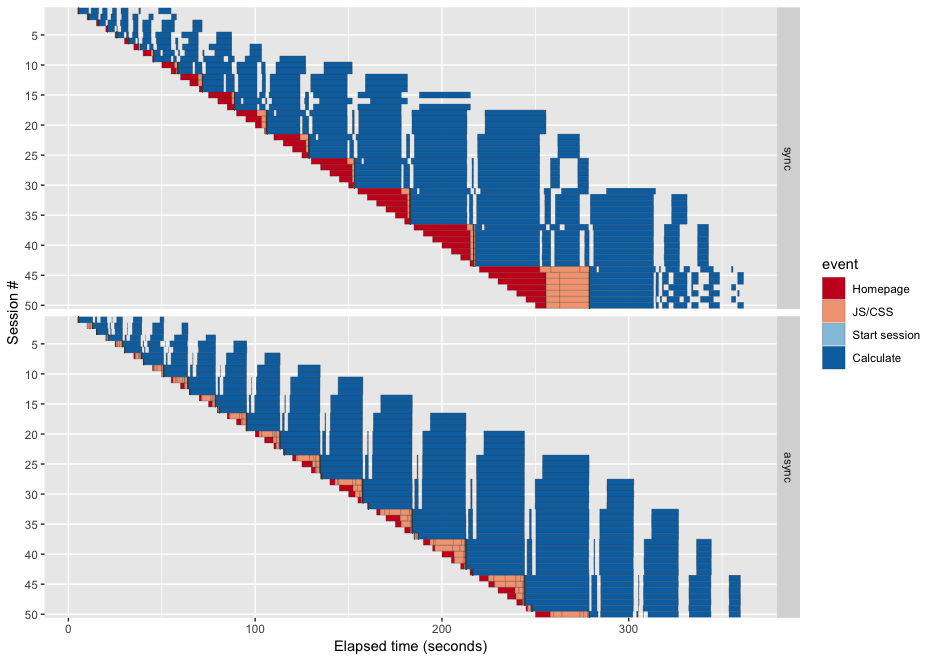
In this plot, each row represents a single session, and the x dimension represents time. Each of the rectangles represents a single “step” in the test script, be it downloading the HTML for the homepage, fetching one of the two dozen JavaScript/CSS files, or waiting for the server to update outputs. So the wider a rectangle is, the longer the user had to wait. (The empty gaps between rectangles represents time the app is waiting for the user to click an input; their widths are hard-coded into the test script.)
Of particular importance are the red and pink rectangles, as these represent the initial page load. While these are taking place, the user is staring at a blank page, probably wondering if the server is down. Long waits during this stage are not only undesirable, but surprising and incomprehensible to the user; whereas the same user is probably prepared to wait a little while for a complicated visualization to be rendered in response to an input change.
And as you can see from this plot, the behavior of the async app is much improved in the critical metric of homepage/JS/CSS loading time. The sync version of the app starts displaying unacceptably long red/pink loading times as early as session 15, and by session #44 the maximum page load time has exceeded one minute. The async version at that point is showing 25 second load times, which is far from great, but still a significant step in the right direction.
Further optimizations
I was surprised that the async version’s page load times weren’t even faster, and even more surprised to see that the blue rectangles were just as wide as the sync version. Why isn’t the async version way faster? The sync version does all of its work on a single thread, and I specifically designed this app to be a nightmare for scalability by having each session kick off by parsing hundreds of megabytes of CSV, an operation that is quite expensive. The async version gets to spread these jobs across several workers. Why aren’t we seeing a greater time savings?
Mostly, it’s because calling
mirai(read_csv("big_file.csv")) is almost a worst-case
scenario for mirai and async. read_csv is generally fast,
but because the CRAN log files are so big,
read_csv("big_file.csv") is slow. The value it returns is a
very large data frame, that has now been loaded not into the Shiny
process, but a mirai daemon process. In order to return
that data frame to the Shiny process, that data must first be
serialized, transmitted to the Shiny process, and then deserialized; to
make matters worse, the transmitting and deserialization steps happen on
the main R thread that we’re working so hard to try to keep idle.
The larger the data we send back and forth to the mirai, the
more performance suffers, and in this case we’re sending back
quite a lot of data.
We can make our code significantly faster by doing more summarizing, aggregation, and filtering inside the mirai; not only does this make more of the work happen in parallel, but by returning the data in already-processed form, we can have much less data to transfer from the worker process back to the Shiny process. (For example, the data for May 31, 2018 weighs 75MB before optimization, and 8.8MB afterwards.)
Compare all three runs in the image below (the newly optimized version is labelled “async2”). The homepage load times have dropped further, and the calculation times are now dramatically faster than the sync code.
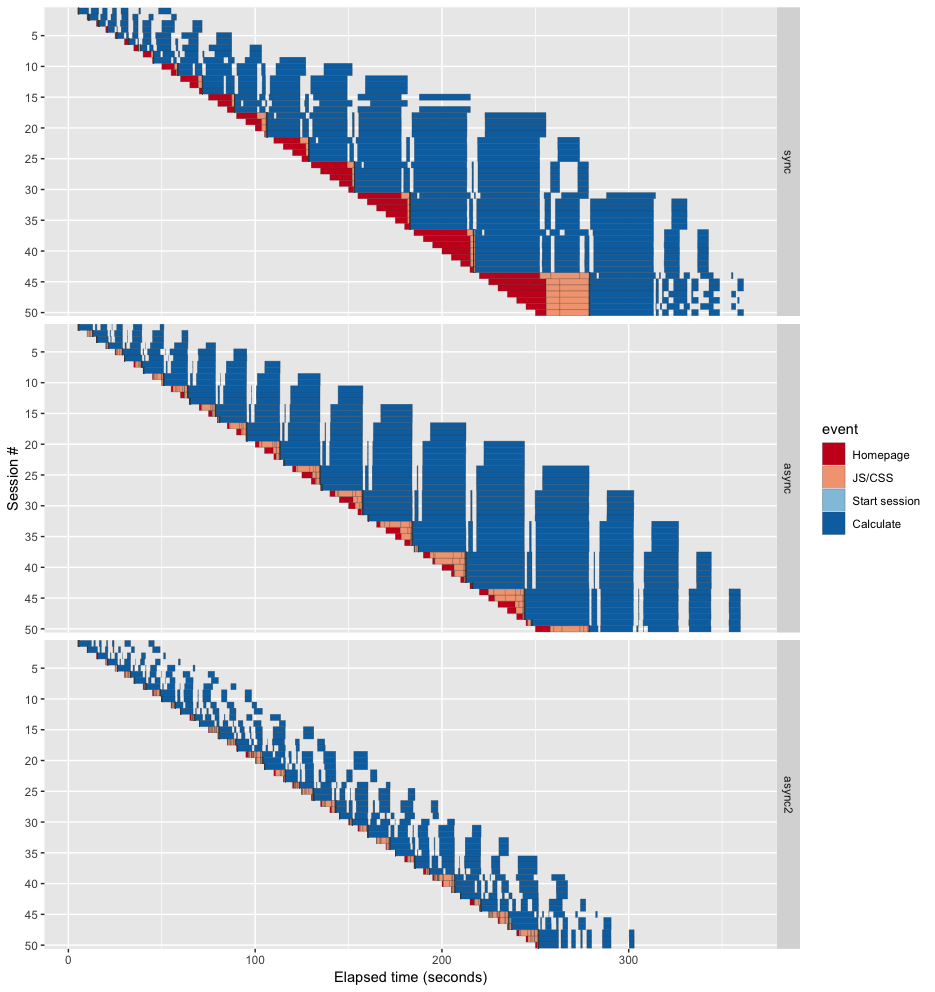
Looking at the “async2” graph, the leading (bottom-left) edge has the same shape as before, as that’s simply the rate at which the load testing tool launches new sessions. But notice how much more closely the trailing (upper-right) edge matches the leading edge! It means that even as the number of active sessions ramped up, the amount of latency didn’t get dramatically worse, unlike with the “sync” and “async” versions. And each of the individual blue rectangles in the “async2” are comparatively tiny, meaning that users never have to wait more than a dozen seconds at the most for plots to update.
This last plot shows the same data as above, but with the sessions aligned by start time. You can clearly see how the sessions are both shorter and less variable in “async2” compared to the others. I’ve added a yellow vertical line at the 10 second mark; if the page load (red/pink) has not completed at this point, it’s likely that your visitor has left in disgust. While “async” does better than “sync”, they both break through the 10 second mark early and often. In contrast, the “async2” version just barely peeks over the line three times.
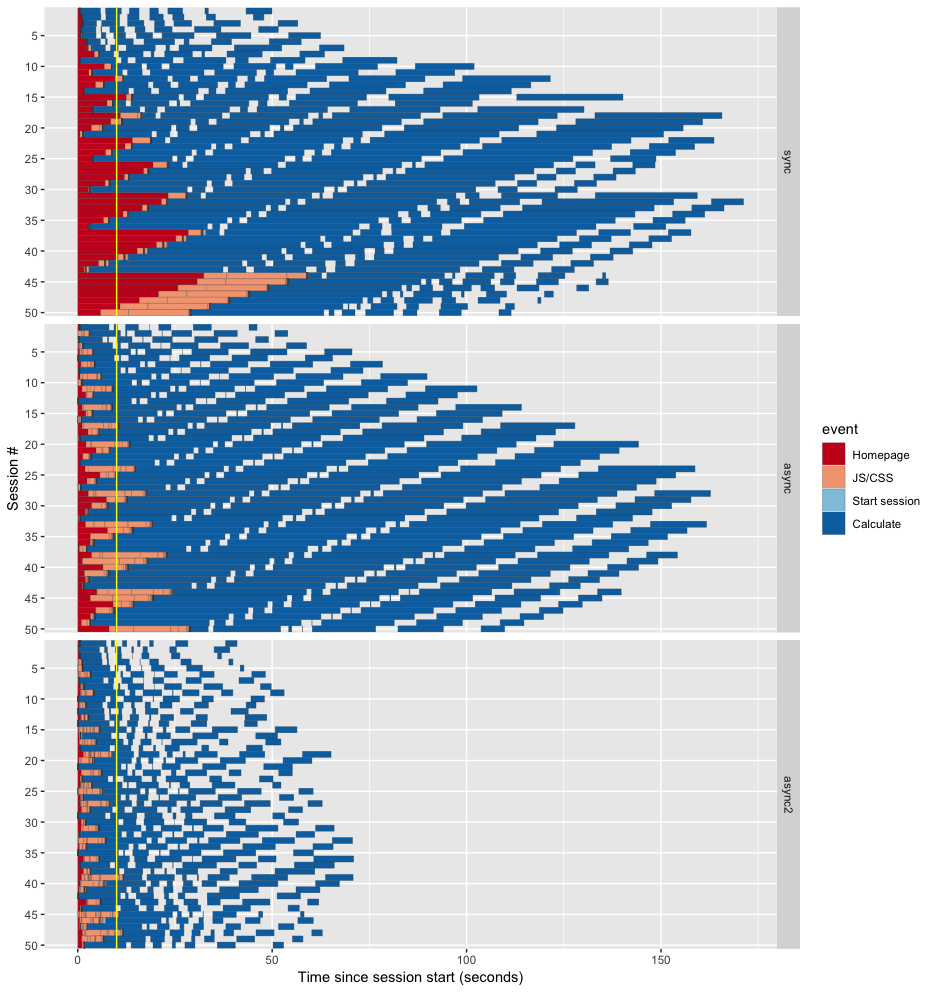
To get a visceral sense for what it feels like to use the app under load, here’s a video that shows what it’s like to browse the app while the load test is running at its peak. The left side of the screen shows “sync”, the right shows “async2”. In both cases, I navigated to the app when session #40 was started.
Take a look at the code diff for async vs. async2. While the code has not changed very dramatically, it has lost a little elegance and maintainability: the code for each of the affected outputs now has one foot in the the render function and one foot in the mirai. If your app’s total audience is a team of a hundred analysts and execs, you may choose to forgo the extra performance and stick with the original async (or even sync) code. But if you have serious scaling needs, the refactoring is probably a small price to pay.
Let’s get real for a second, though. If this weren’t an example app written for exposition purposes, but a real production app that was intended to scale to thousands of concurrent users across dozens of R processes, we wouldn’t download and parse CSV files on the fly. Instead, we’d establish a proper ETL procedure to run every night and put the results into a properly indexed database table, or RDS files with just the data we need. As I said earlier, a little precomputation and caching can make a huge difference!
Much of the remaining latency for the async2 branch is from ggplot2 plotting. Sean’s talk alluded to some upcoming plot caching features we’re adding to Shiny, and I imagine they will have as dramatic an effect for this test as they did for Sean.
Summing up
With async programming, expensive computations and tasks no longer need to be the scalability killers that they once were for Shiny. Armed with this and other common techniques like precomputation, caching, and load balancing, it’s possible to write responsive and scalable Shiny applications that can be safely deployed to thousands of concurrent users.